Minds On
Warm up
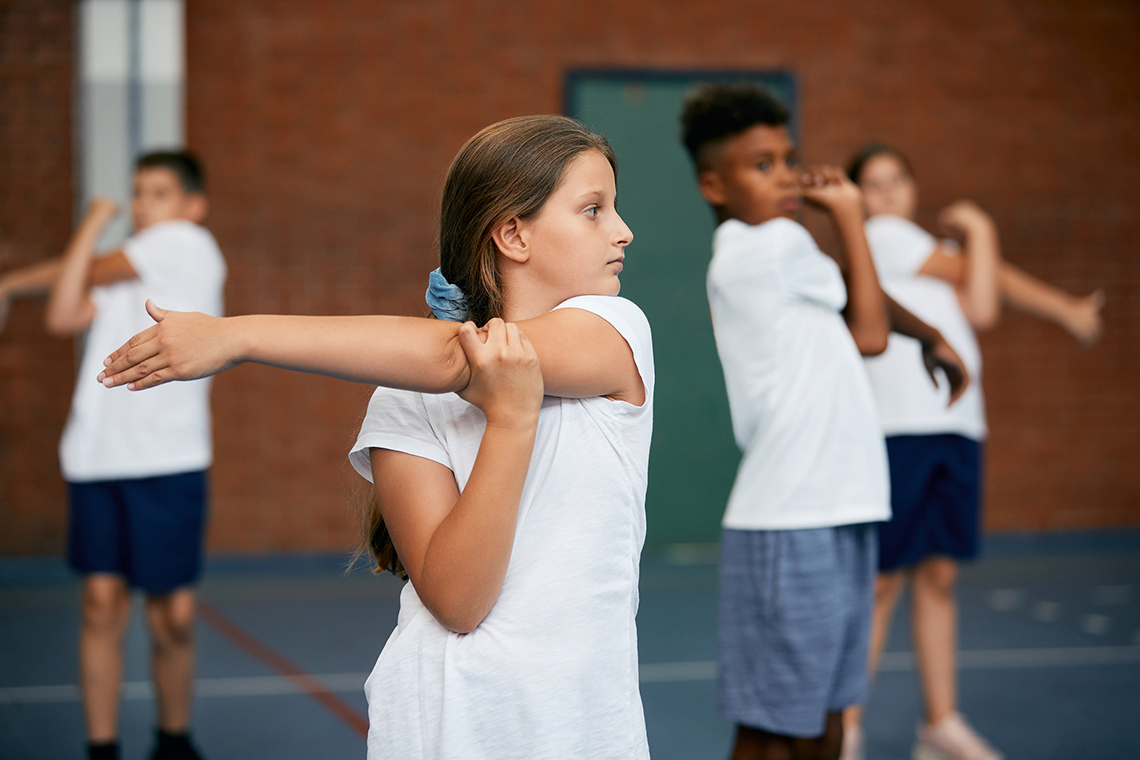
Don’t forget to do your safety check!
Warm Up
Breathe in and out
For our warm-up activity, access this audio clip entitled “Breathing Activity” to learn more about taking deep breaths.
Breathing Activity
Find a comfortable position. Focus your attention on one part of the body at a time.
How does that part of your body feel? If possible, take a deep breath and allow your lungs to expand.
Now, focus your attention on one part of your body. Allow that part to relax before moving on to the next.
As you scan through your body, keep breathing deeply.
Once you have completed the scan, take a moment to stretch.
Drama game
If possible, set a timer for 3 minutes. In those 3 minutes, record anything about yourself that is associated or has a connection with any of the following words given.
- pear
- a month
- hill
- a lake or river
- rowing
Press ‘Example’ to help you get started.
At the end of 3 minutes, stop recording. If possible, share your connection with a partner.
Let’s get started!
Explore the following image:

6 children standing in different levels and heights, from low, medium, and high. Each child is frozen and has a different expression. From left to right; Learner A is turned to the group and questioning, with an arm gesture, while standing. Learner B is sitting with one knee on the ground at a medium height, and their hand on their chin. They are thinking. Learner C is really low to floor and seems to be thinking as well. Learner D is upright and has a hand gesture of one finger close to their mouth, while telling the others to be quiet. Learner E is sitting with one knee on the ground at a medium height, and also has their hand on their chin while thinking with a serious look. Learner F is standing upright, and has their hands out at their side, while looking towards Learner A.
Consider:
- What are they doing?
- Describe their poses and facial expressions.
- What kind of message are they trying to convey?
Record your ideas in a notebook or another method of your choice
Let’s check out the second image.

6 children standing in different levels and heights, from low, medium, and high. Each child is frozen and has a different expression. From Left to right; Learner A is turned to the Learner F and questioning, with an arm gesture, while standing and slight bent. Learner B is sitting with one knee on the ground at a medium height, with a surprised expression and their mouth opened, while turning to look at Learner F. Learner C is really low to floor and is pointing their thumb towards Learner F. Learner D is upright and has a hand gesture of one finger pointing to Learner F. Learner E is sitting with one knee on the ground at a medium height, and has their hand out, while turning to look at Learner F with a shocked expression. Learner F is standing upright, and has their hands out at their side, while looking towards the entire group.
- Have their poses changed? Have their facial expressions changed?
- What might have happened between the first image and the second?
Record your thoughts and if possible, share your thoughts with a partner.
Now, let’s check out the following image of a coffee plant life cycle.

A coffee bean seed growing in seven stages. First stage is the small seed. Second stage is the germinated seed. Next is the seed becoming a seedling, followed by the seed growing a leaf, and then becoming a plant with a stem. The following stages are the plant slowly growing in height with more leaves.
- How are the plants the same?
- How are they different?
- What do you notice about the height of the plants?
Record your ideas in a notebook or another method of your choice.
Action
Get ready, get set…
Tableau
In the Minds On section, we explored a tableau.
A tableau is a silent, motionless picture. In drama, we can use tableaux to express different themes, feelings, and ideas. Tableaux may be presented as stand-alone images to communicate one specific message or may be used in a longer drama work.
Explore this video entitled “What is a Tableau?” to learn about the four different features of a tableau. The four features are stillness, facial expressions, filling the space, and levels.
Press the following tabs to access ideas about how you might create your tableau.
Character refers to:
- Who/what is important in this story/moment or idea?
- Who might we need in our tableaux to tell a story without words?
- What is the relationship between the characters and how can people use their body language to communicate those relationships?

When we think of space, consider how we might use the space to communicate mood and/or tension?

Referring to gestures and expressions, how might we use our face and bodies while remaining frozen to express feelings and ideas?
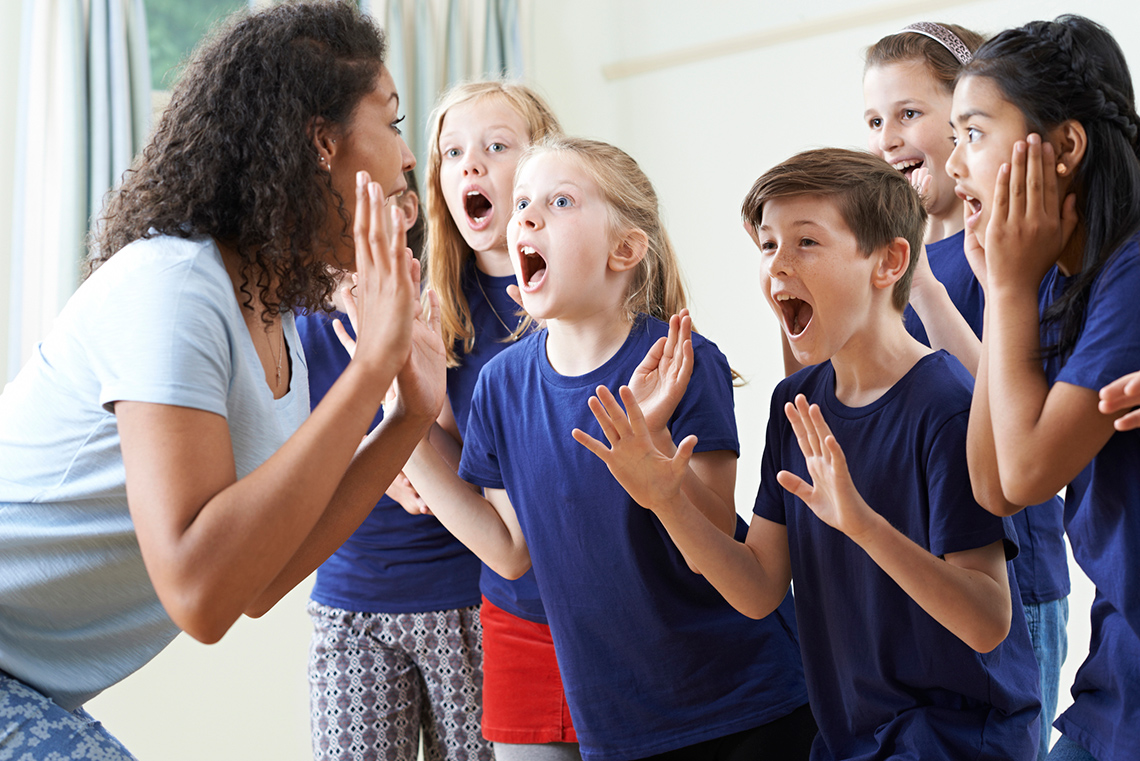
For focal points or levels, consider how might we use a variety of levels (high/medium/low) in our frozen pictures to create an interesting focal point?
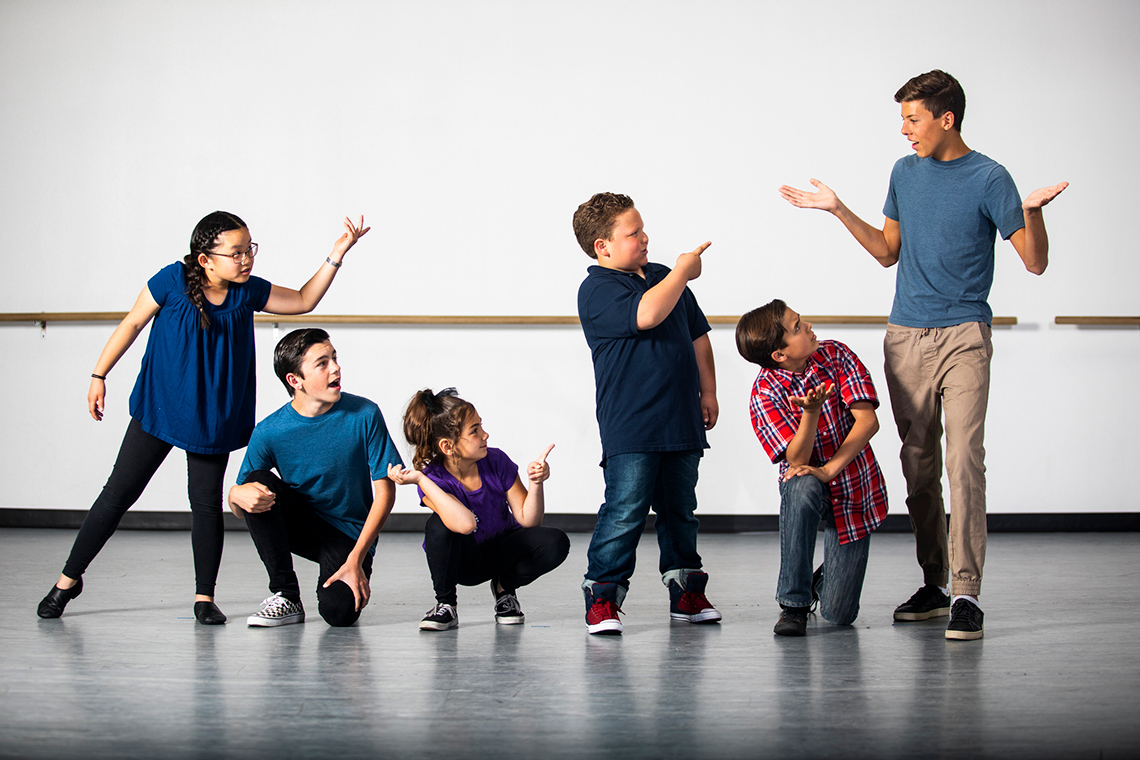
Try It
Act it out!
Let’s explore the life cycle of a coffee plant.

Life Cycle of a Coffee Plant
The life cycle of a coffee plant: First, start off with the seeds of a coffee plant, like coffea arabica. Next, plant the seed with soil, sunlight, and water. The seed with germinate, then sprout from the soil. Afterwards is the seedling stage, where the plant grows leaves. Then, the plant matures and becomes a tree. From the tree, buds blossom into flowers. Finally, the tree produces a fruit, coffee cherry, from which the cycle resumes with the seeds from the fruit.
Imagine being a coffee bean.
How might you represent each step of the plant’s cycle using:
- space
- gestures
- levels
1. Create a tableau for each step in your life cycle.
2. Next, consider how you might transition between each step.
3. Then, practise and present your tableau to a partner, if possible.
You may also create a video recording of your tableau or a description of how you might transition through each stage of the coffee plant’s life cycle.
Consider adding your work to your drama portfolio.
Press ‘Option’ to explore an alternate activity.
Alternatively, select one of the stages in the coffee plant’s life cycle.
Then, narrate and/or describe that moment in the plant’s growth.
Be sure to add details about what might have happened before, and what might happen after this stage in the plant’s development.
Record your description in a notebook or another method of your choice.
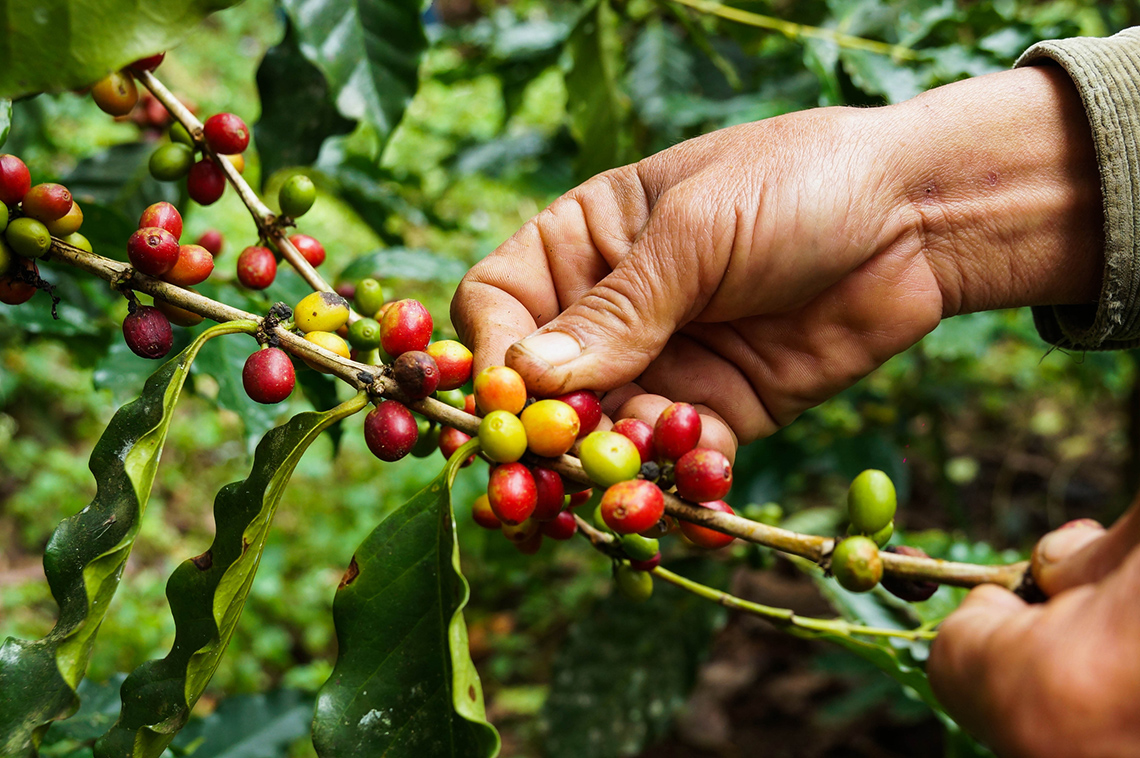
Pause and Reflect
Pause and reflect
After creating the tableau or description, reflect on the following:
- How might using tableaux to share the life cycle of a coffee plant help connect us to the land?
- What did you learn from creating your tableaux or description?
Record your thoughts in a notebook or another method of your choice.
Memory

A memory is a record someone keeps of past experiences. The brain stores these experiences and important information to be used in the future.
A person’s memory encodes information, stores information, and then finds information when they need it.
With the word “memory,” what feeling do you associate with it?
For some people, they recall a memory when they are experiencing something that is similar. They might experience a similar taste, smell, feeling, or a place that reminds them of an experience they’ve had.
For example, Learner B likes their grandpa’s chocolate chips cookies. When baking their own cookies, Learner B remembers their grandpa’s tasty cookies.

Memory and Indigenous knowledge
“All things and all people, though we have our own individual gifts and special place, are
dependent on and share in the growth and work of everything and everyone else. We believe
that beings thrive when there is a web of interconnectedness
between the individual and the community, and between the community and nature. Everything
we do, every decision we make, affects our family, our community, it affects the air we
breathe, the animals, the plants, the water
in some way. Each of us is totally dependent on everything else.”
- Dr. Evelyn Steinhauer, member of Saddle Lake Cree First Nation
As there are so many nations and communities that exist across Turtle Island, the name that many First Nations communities use to refer to the lands known as North America, Indigenous worldviews are also quite diverse. Specific First Nations, Metis, and Inuit worldviews are transmitted through community traditions, teachings, ceremonies, creation stories, and languages.
Memory is a vital part of passing down traditions and ways of living. Each generation learns from their family, Elders and Knowledge Keepers or community member about how their ancestors lived and interacted with the world around them.
Indigenous worldviews offer a different perspective on understanding science and the environment. Indigenous worldviews consider the interconnectedness of all living things. Though distinct, most if not all Indigenous perspectives believe that the land, the waters, the sun, the moon, the rocks, the hills, the mountains, the wind, the sky, and everything — they all have a spirit and are animate, living things.
Within many Indigenous languages, the names for the rocks, the lands, and the waters are described using animate language, because of the spirit that lives within each. Within Indigenous worldviews, it is understood that all of the elements in the universe are connected and dependent on one another for life. Humans are not superior to any other living part of the Earth. Rather, humans must respect the Earth and treat it well, not just for this generation, but for many generations to come.

Pause and Reflect
Pause and reflect
- What are some examples from your own life of how you respect the land?
- How did you learn to care for the land? Did someone teach you?
Record your ideas in a notebook or another method of your choice.
Shi-shi-etko: Memory bag
In the story, Shi-shi-etko by Nicola I. Campbell, Shi-shi-etko is given a small bag by her Yayah, who said “This, my girl, is a bag for you to keep all of your memories. No matter where you go, no matter what you do, remember to keep them safe.”
What do you think Yayah means?
Explore the following pages:

Page 19 & 20
Shi-shi-etko was dreaming when she hear her Yayah say, “Shi-shi-etko, wake up, my girl. We have some things to do today.”
Yayah gave her a small bag made from soft, tanned deer hide and sinew. “This, my girl, is a bag for you to keep all your memories. No matter where you go, no matter what you do, remember to keep them safe.”
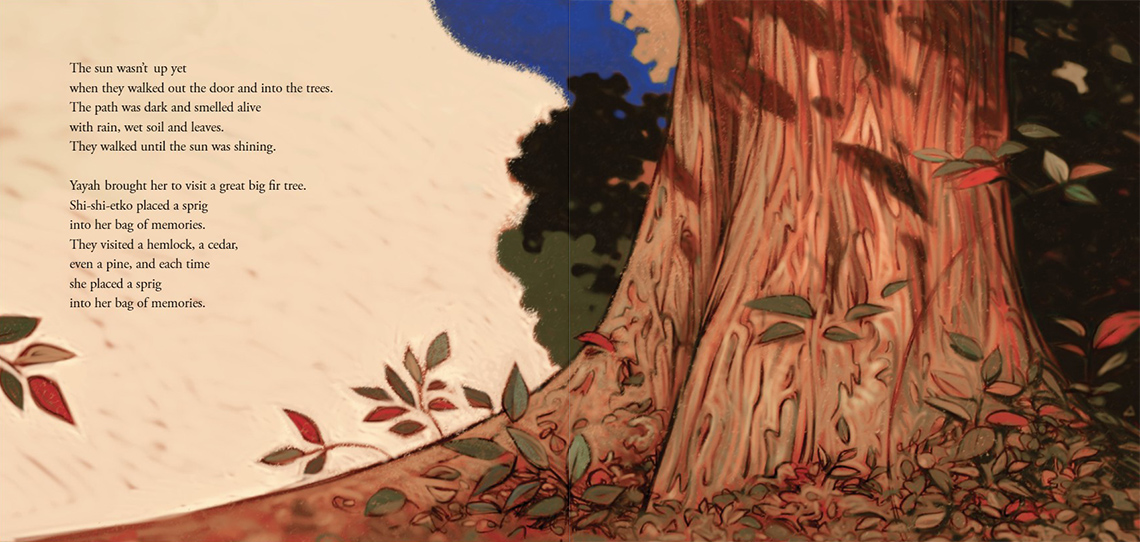
Page 21 & 22
The sun wasn’t up yet when they walked out the door and into the trees. The path was dark and smelled alive with rain, wet soil and leaves. They walked until the stun was shining.
Yayah brought her to visit a great big fir tree. Shi-shi-etko placed a sprig into her bag of memories. They visited a hemlock, a cedar, even a pine, and each time she placed a sprig into her bag of memories.
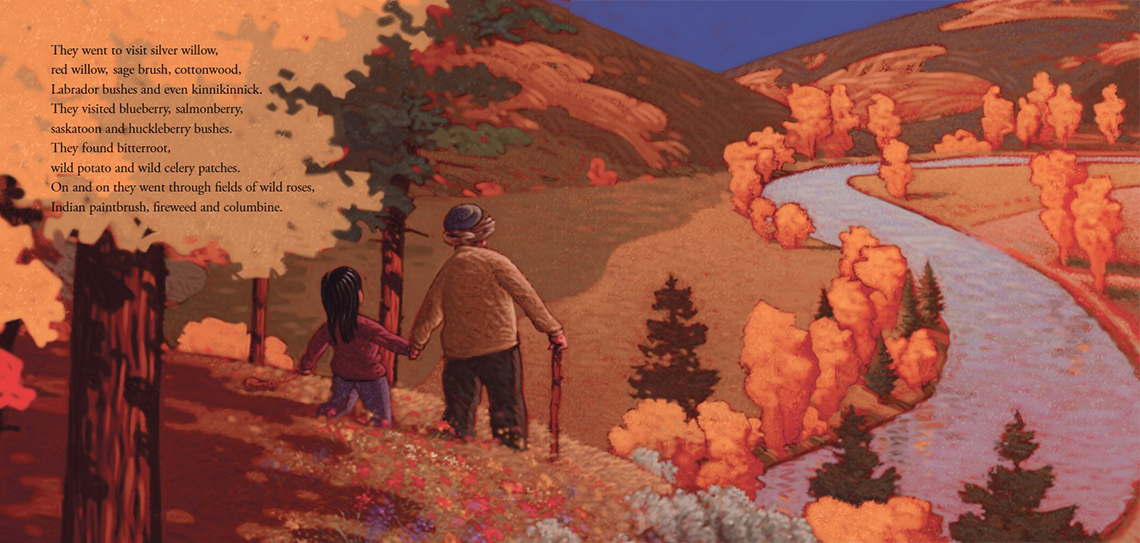
Page 23 & 24
They went to visit silver willow, red willow, sage brush, cottonwood, Labrador bushes and even kinnikinnick. They visited blueberry, salmonberry, saskatoon and huckleberry bushes. They found bitterroot, wild potato and wild celery patches. On and on they wen through fields of wild roses, Indian paintbrush, fireweed and columbine.
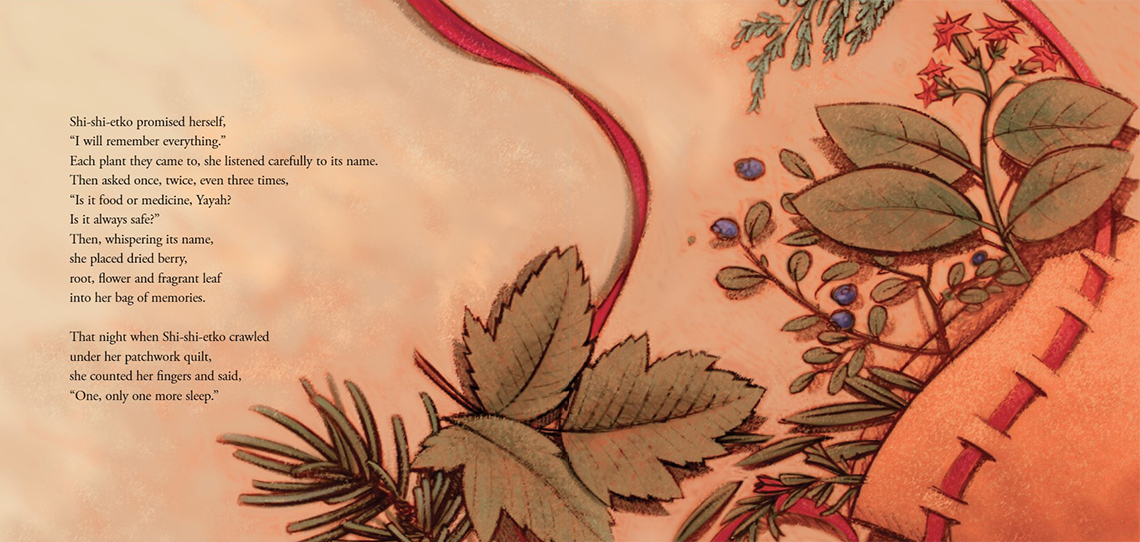
Page 25 & 26
Shi-shi-etko promised herself, “I will remember everything.”
Each plant they came to, she listened carefully to its name.
Then asked once, twice, even three times, “Is it food or medicine, Yayah? Is it always safe?”
Then, whispering its name, she placed dried berry, root, flower and fragrant leaf into her bag of memories.
That night when Shi-shi-etko crawled under her patchwork quilt, she counted her fingers and said, “One, only one more sleep.”
After exploring the recent pages from Shi-shi-etko, reflect on the following questions:
- How does Shi-shi-etko use her memory bag?
- What are some of the memories that Shi-shi-etko keeps safe in her memory bag?
- What are some of the ways that Shi-shi-etko and her family show respect for the land?
Record your responses in a notebook or another method of your choice.
Go!
Your memory or idea
What memories come to mind when you think of an important and exciting event in your life?
You could also create an idea of a future event, something that you would like to experience.
The drama technique called a memory scan can help to identify important parts of a memory. It can be used to help you visualize or consider your idea as well.
Try It
Memory scan
Choose a memory to complete a memory scan.
Consider the following questions to complete a memory scan:
- What is important in your memory?
- What were the specific details around you?
- What were the personalities of the people or person?
- Did anyone speak or communicate in another way in your memory?
- Is there a special focus in your memory on a real object (e.g., a painting, a sofa, a sound, etc.)
Record your ideas in a notebook or another method of your choice.
Consider adding your work to your drama portfolio.
Consolidation
Tableau
Portfolio
Create a tableau
Check out the following steps to create your own tableau.
- Choose a memory or idea you would like to express in a tableau or a short
description.
Consider:
- character
- space
- gestures/expressions
- focal point
Complete the Create A Tableau Activity in your notebook or using the following fillable and printable document. If you would like, you can use speech-to-text or audio recording tools to record your thoughts.
Consider adding your work to your drama portfolio.
Create A Tableau Activity
For the tableau activity, choose a memory or idea you would like to express in a tableau or a short description. Consider the following tableau components and guiding questions.
Tableau Components My Ideas and Responses Character:
Who is the character in my tableau?
Space:
How can I use the space around me to convey the moment?
Gestures
/expressions:Will I use my face, body, or another method to express my feelings and ideas?
Focal Point:
How might I use levels to create a focal point?
Press the ‘Activity’ button to access Create A Tableau Activity.
- Once you have created your tableau, decide if you would like to add another moment or series of moments before or after.
- After creating the additional tableaux, decide on how you would like to transition.
- Practise your tableau/description and share your responses to the Create A Tableau Activity with a partner, if possible.
Response
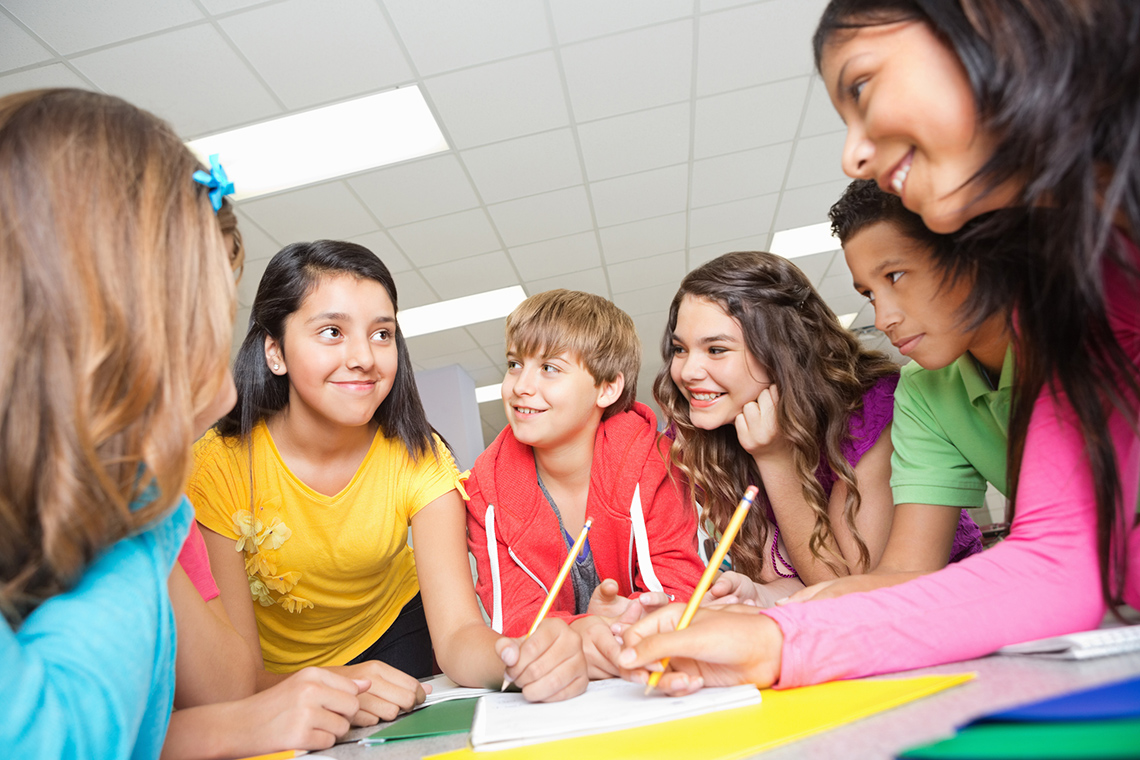
Portfolio
Final thoughts
Let’s gather our thoughts and respond to the following questions.
- How can we use tableaux to explore new ideas?
- What did you learn from Shi-shi-etko’s experiences and education?
- Do you have any new learnings about Indigenous knowledge? If so, what might they be?
- How are your experiences similar or different to Shi-shi-etko’s experiences and education?
- How might you show respect for the land and water?
Record your ideas in a notebook, or another method of your choice. Consider adding your work to your drama portfolio.
Reflection
As you read through these descriptions, which sentence best describes how you are feeling about your understanding of this learning activity? Press the button that is beside this sentence.
I feel…
Now, record your ideas using a voice recorder, speech-to-text, or writing tool.


